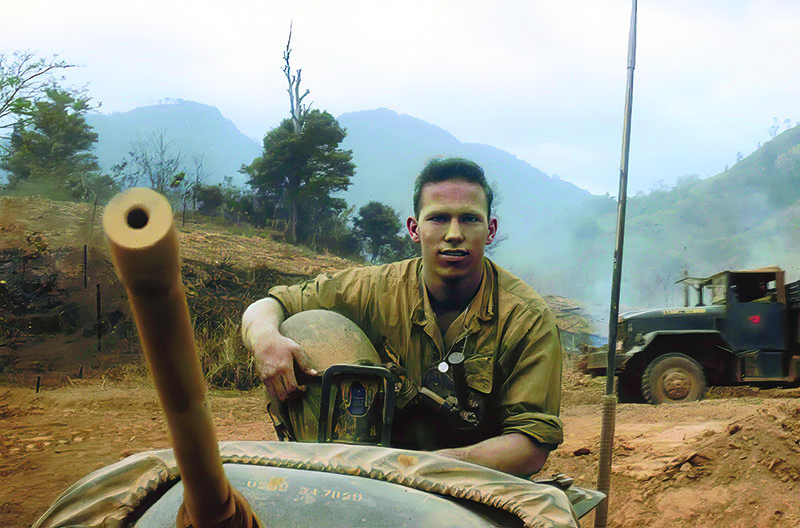
The Birthday Brawl: Tankers Hold the Line at Khe Sanh
By: Kyle WattsPosted on July 15, 2025
First Lieutenant Harris Himes stabbed holes around the side of an empty C-ration can. He ignited a heat tab inside and warmed his breakfast over the flame. The alien aroma of beans and weenies flared his hunger pangs, gratefully supplanting the reek of diesel fumes thickening the air. Two of his tanks idled on the road nearby. Himes commanded the 1st Platoon of “Bravo” Company, 3rd Tank Battalion, 3rd Marine Division, with five tanks under his charge. Infantrymen bustled about the area preparing for the mission at hand. Each had begun their day long before dawn. Now, a tired sun stirred on the eastern hills, reluctantly ascending over the battle-scarred landscape of Khe Sanh Combat Base.
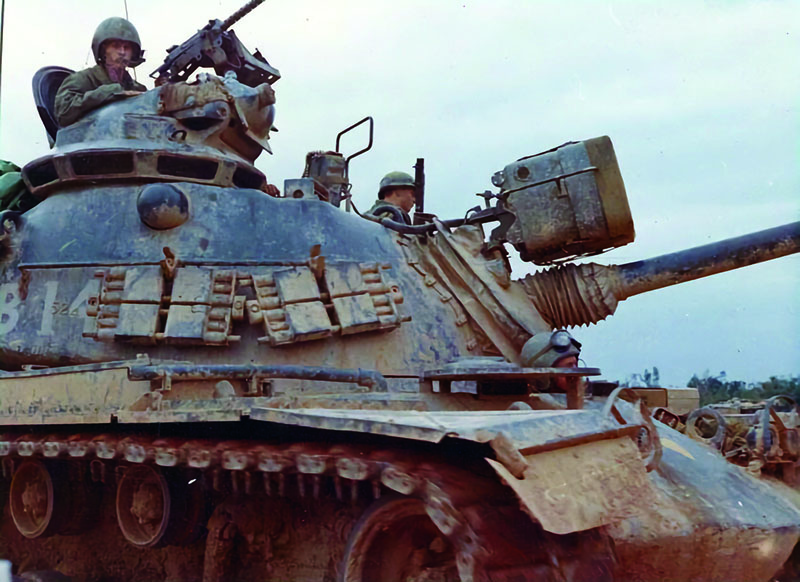
Corporal Fred Kellogg waited impatiently outside the supply hooch, holding his M3 submachine gun. A line of grunts formed ahead. The sergeant in charge doled out bullets like a munificent millionaire dispensing Halloween candy from the portico of his mansion. When his turn arrived, Kellogg approached with his antiquated weapon extended, an empty bucket desperate for a treat.
“Good morning, Sergeant. I really need some new magazines for this grease gun. The springs are all worn out. They won’t hardly feed anymore.”
The sergeant glared at Kellogg. This was not the first time the tanker had come whining about his worthless weapon.
“Corporal, if the Marine Corps wanted you to have new magazines, it would have given you new magazines! Now get the hell out of my tent!”
A litany of profanity hounded Kellogg back to his tank and trailed off below the rumbling diesel engine. Kellogg climbed aboard and dropped into the tank commander’s (TC’s) hatch, tossing the grease gun aside with a slew of opinions about the supply sergeant. He ignored the looks from the rest of his crew as he prepared to roll out.
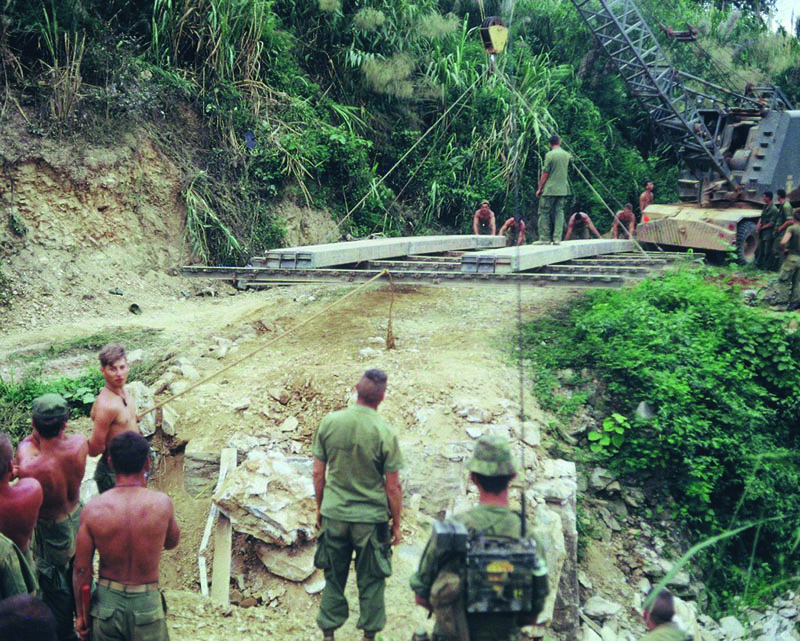
Kellogg positioned his tank, call sign B-12, on point leading out the Khe Sanh gate. Cpl Adrian “Buzz” Conklin com-manded B-13 in line behind him. The remainder of Himes’ platoon staged behind in a separate supply convoy. The two lead tanks would accompany an advance party of grunts from Fox Com-pany, 2nd Battalion, 1st Marines, sweeping ahead in search of mines laid overnight or an enemy ambush lying in wait. Today, of all days, that prospect felt surely to become reality.
It was May 19, 1968, Ho Chi Minh’s birthday. Intelligence reports streamed in over the preceding week. The North Vietnamese Army (NVA) around Khe Sanh seemed hell-bent on blocking the road out of the base and perhaps, after months of siege warfare, finally overrunning the American encampment as a gift for their leader.
The infamous siege of Khe Sanh was already over in the eyes of the world. The combat base and surrounding hill outposts had held. The NVA had failed. Much of the air support so critical to sustaining life through the siege was diverted. Virtually all the media attention shifted elsewhere. To the Marines who remained, however, a steady dose of enemy rockets and mortars belied the prevailing attitude.
Just the month prior, American commanders organized Operation Pegasus for the overland relief of Khe Sanh. Ma-rines and 1st Cavalry Division sol-diers struck out westward from their base at Ca Lu, while the defenders of Khe Sanh surged from their fighting positions in a coordinated effort. By mid-April, engi-neers cleared or rebuilt the impassable stretches of the main supply route be-tween the two combat bases, called Route 9.
Even after the official conclusion of Pegasus, Route 9 remained a tenuous 16-kilometer gauntlet. Himes’ platoon spearheaded the armored relief of Khe Sanh, arriving at the combat base at the beginning of May. Within days, the tank-ers battled through an ambush along Route 9 while escorting the platoon they relieved back to their home base in dire need of repairs. Himes’ mission now was to protect convoys moving along the treacherous route.
Himes issued assignments to his Marines the night before the May 19 supply run, placing Kellogg and Conklin with the mine sweep and two additional tanks with the main column that would depart once the advance party returned. Nearly his entire platoon held a role in the day’s mission. Himes served not only as the lieutenant in charge of the tankers, but one of the most experienced. He arrived in Vietnam in July 1967. That August, Himes was seriously wounded while com-manding a tank in combat and was evacuated to a hospital ship. He returned with his arm still in a sling to finish his tour. Much of his platoon rotated home at the end of the year and a fresh batch joined in January 1968. Several newcomers, like Kellogg, arrived as green lance corporals but were promoted and assigned as TCs in short order. Their limited combat exper-ience notwithstanding, Himes trusted their instincts and judgment.
Kellogg tested B-12’s internal comms. Charles Lehman sat to his left as loader, servicing the tank’s main gun and coaxial-mounted .30-caliber machine gun. Carlos Trinidad sat in front of Kellogg as the gunner and Stanley Williams occupied his own compartment forward as the driver. Kellogg loaded bullets into his faulty grease gun magazines. He placed the weapon in the rack behind his seat with the tank’s cache of hand grenades. He counted 19, an unusually high number. Since the M48A3 Patton tank possessed a 90 mm main gun, tankers rarely found the need to pop out of their hatch and toss a grenade.
Kellogg inspected the .50-cal. machine gun mounted inside his cupola. The space was so cramped that nothing more than a 50-round belt of ammo would fit preloaded into the weapon. Worse, some engineer back in the States decided to save space by mounting the gun on its side, oriented to fire in a way it was not designed. Tankers cursed the weapon and its tendency to jam even before the paltry 50 rounds fed through. The gun’s most valuable purpose served as an additional block of metal in front of the TC’s face. This “additional armor” saved Himes’ life when he was evacuated the previous fall, shielding him from a direct hit by a rocket propelled grenade (RPG).
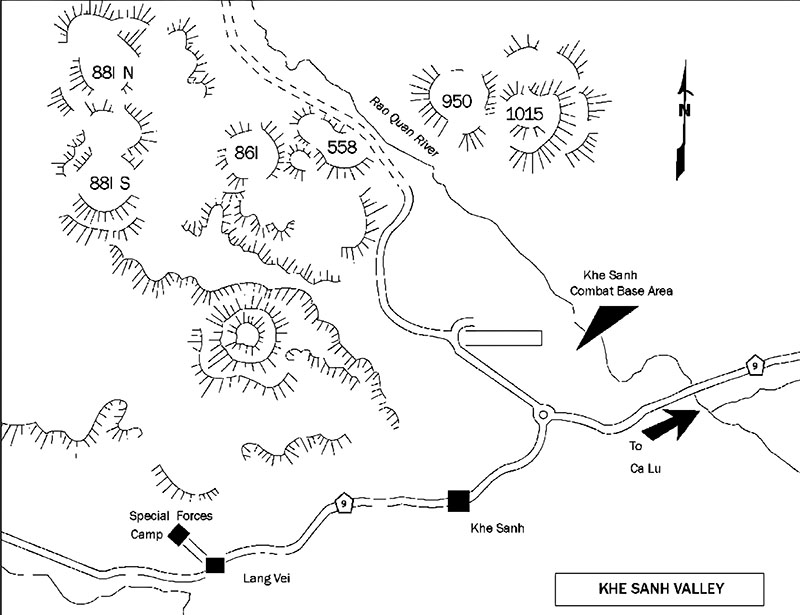
Lehman extracted a 90 mm canister round from a honeycomb storage rack and shoved it into the main gun’s breach. Experience thus far proved these tank-sized shotgun shells most effective at disrupting an enemy ambush. Fox Company Marines moved ahead with their mine sweepers. Kellogg waited for them to exit the wire. He turned back, surveying Conklin’s tank and the rest of the convoy readying behind him. Himes stood in the road, breakfast in hand. He flashed a smile and thumbs up. Kellogg returned the gesture as the tank throttled up and rolled out.
It was 7 a.m. Innocent morning rays illuminated a pristine blue sky, clear and fresh before the midday heat. Preceding months of conflict left the area barren. Ghoulish trees cast gangly shadows across exposed red earth. Emaciated shrubbery punctuated irregular patterns of bomb craters in every direction. The road out of Khe Sanh led directly through this no man’s land, linking up with Route 9 in the surrounding hills. Uncle Ho’s expected birthday violence hung heavy over the column. How far would the convoy make it this time before the NVA attacked? The Marines pressed on, their incipient sense of disaster kindling.
The grunts worked their mine sweepers back and forth. Less than half a mile outside the gate, Kellogg’s radio crackled to life.
“Charles is in the area.”
Every Marine knew “Charlie,” the commonly held term for enemy, but “Charles?” What was the radio operator trying to say? An AK-47 opened up from a hedgerow in prompt explanation. Less than 100 feet away, concealed NVA sprang the ambush. Kellogg dropped into his seat. A ring of vision blocks sur-rounded the bottom of his cupola offering limited visibility outside. Grunts in the kill zone hit the deck, cut down by enemy fire or taking cover. Kellogg shouted through the intercom to Williams.
“Let’s go! Kick it in the ass and get us up front!”
The 50-ton machine surged forward. Bullets ricocheted off the armor as Kellogg directed Trinidad onto the bushes. The canister round boomed, devastating everything in its swath. Kellogg toggled a switch, changing the trigger controls from the main gun to the coaxial-mounted machine gun. Trinidad unleashed .30-cal. rounds as Lehman removed the spent 90 mm brass and inserted another main gun round.

Kellogg triggered his .50-cal., spraying five-round bursts along the hedgerow. Maliciously on cue, the machine gun jammed. His efforts to correct the prob-lem proved futile in the constricted cupola. Mayhem enveloped the tank. Dozens of NVA soldiers attacked from bushes and bomb craters at point-blank range. Kellogg directed Trinidad as he fired another round through the main gun, while simultaneously guiding Williams around the Marines exposed outside. How could they possibly fire, or even move, without killing one of their own?
“Traverse right.”
The thought breached Kellogg’s internal monologue without prompting, an overwhelming premonition without explanation. He obeyed. He clutched the TC override controls, arresting command from Trinidad, and spun the turret right as fast as it would move. When the main gun stood out at a 90-degree angle, the tank rocked violently as an RPG detonated on the turret. Kellogg’s intuition saved the tank. The well-aimed shot hit squarely on the gun shield, the thickest point of armor.
Smoke cleared from the vision blocks. Trinidad’s frantic voice screamed through the headset.
“I see them! I see them! I see them!”
The enemy RPG team stood in the open, taking aim once again. The tank’s gun pointed directly at them, loaded with a high explosive round. Kellogg estimated the range; they looked too close. Internal safeties prevented rounds from detonating before they reached a specified distance from the tank. Kellogg instantly decided he had to fire first. He squeezed the trigger on his override controls. The round blasted into the dirt at the RPG team’s feet, reaching bare-minimum range to explode. The enemy soldiers vaporized into pink mist.
Back inside the combat base, Himes wrapped up his morning routine brushing his teeth. His blouse clung to his sweaty back as he bent and spat out the toothpaste. To live in Vietnam was to endure habitual humidity. The sun had yet to perch on its high, oppressive throne. Staccato small arms echoed in the distance. The quickening tempo bade each Marine within earshot swivel and stare. Finally, the unmistakable crescendo of a tank’s main gun tolled. Barely half an hour passed since the mine sweep departed. Lance Corporal Jack Butcher sprinted up as the battle reverberated with a fever pitch.
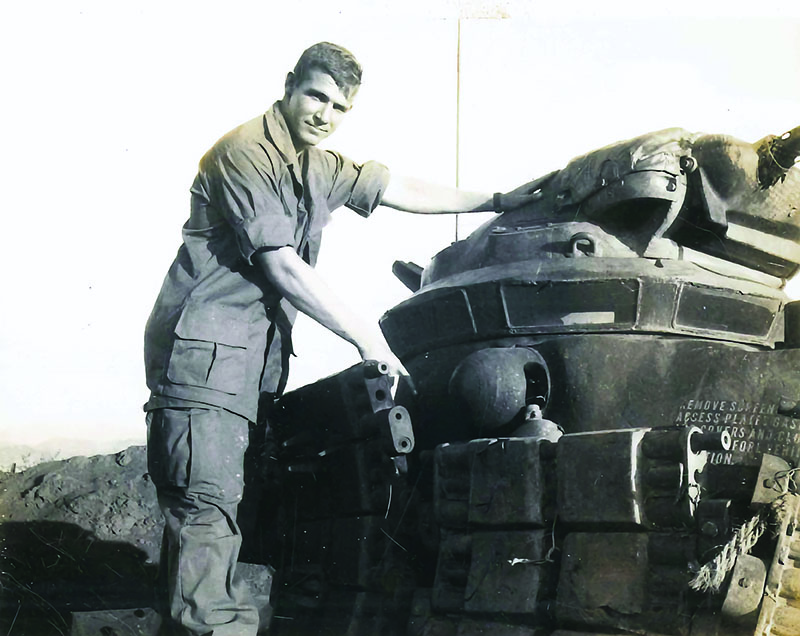
“Lieutenant! One-Two and One-Three have really gotten into something! I was monitoring the radios, and it sounds like it has really hit the fan!”
Himes ran with Butcher back to his tank, B-15, and climbed into the cupola. He ordered Cpl Rene Cerda, B-15’s TC, to collect his crew and crank up the engine. Himes grabbed a helmet. The battle played out through his headset in excited spurts.
“… over to your right …”
Machine-gun fire smothered the words.
“… a whole load of ‘em in the bushes … ”
A 90 mm roared.
“Bravo One-Two, this is Bravo One, over,” Himes chimed in on the net. Heavy breathing followed a long pause.
“Bravo One … this is One-Two … over.”
Kellogg’s reply sounded more animated than ever.
“One-Two, what’s going on out there?”
“Looks like we woke somethin’ up. Started out small, just a couple of shots after the grunts … ”
Static interrupted the words.
“ … then we got into the show and all hell broke loose.”
“One-Two, you’re breaking up. How are you doing?”
“OK so far. Busy.”
“Roger, keep at it. Keep me informed when you can.”
“Roger, One-Two out.”
Himes raised Conklin’s tank.
“Bravo One-Three, this is Bravo One, over.”
“One, this is One-Three,” Conklin replied. “SITREP the same. Lotsa enemy scramblin’, over.”
“Roger. Do it to ’em. Let me know. Out.”
Himes stood on the TC seat, half exposed above the cupola. Cpl Cerda waited further instruction.
“Rene, get over to the comm shack and try to raise someone from regiment,” Himes ordered. “We need permission to get out there and help Fred and Buzz right now!”
Himes dropped back inside the turret with the radio. Another quarter hour ticked by, the battle raging within earshot dreadfully narrated through his headset. Cerda had still not returned. Himes ordered his platoon sergeant to get the remaining tanks ready to roll, then took off for the comm shack. He found Cerda exasperated, radio in hand.
“They’re still looking for someone, Lieutenant. Nothing yet. Not sure regiment even knows what’s happening out there.”
“Stay with it.”
Himes walked back towards B-15. His remaining tanks occupied the road. Infantrymen staged in silent company listening to the chaotic show. What the hell was taking so long?
B-12’s main gun thundered once again, spraying canister fire through a row of bushes. Kellogg squinted through the vision blocks searching for additional targets. Miraculously, numerous Marines outside survived the onslaught thus far. To avoid running them over, Kellogg knew, would be the greater miracle. A lone grunt flashed into the scene framed by his vision block. Haggard, bleeding, and armed with nothing but his Ka-Bar fighting knife, the Marine charged head-long into a bomb crater full of NVA. He stabbed and slashed in a frenzy of gory violence until the tank turned block-ing Kellogg’s view, the grisly scene jettisoned in its wake. A bush rotated into the pic-ture. As if on cue, a World War II-vintage “potato masher” stick grenade arched up and away from the bush, landing in front of the tank near a scattering group of Marines with the fuze still burning.
“Drive over it!” Kellogg shouted.
Williams stopped the tank on top of the grenade, smothering the blast between the road wheels. The tank pushed forward unfazed to the bush where an NVA soldier ducked away into a spider hole. Straddling the hole, Williams threw the tank into a neutral steer, one tread moving forward while the opposite moved backward, rotating the machine in place. The treads dug into the earth, snagging the enemy soldier and crushing his hiding place. Williams shifted both treads forward, dragging the doomed enemy out of his hole and through the tread’s rear sprocket.
Enemy fire increased from B-12’s opposite flank where B-13 sat motionless on the battlefield. Through the drifting smoke, Kellogg noted his sister tank’s main gun blast deflector canted at an odd angle, damaged by an enemy RPG or mortar. Firing the main gun in this condition could mean catastrophic failure for the Marines inside the turret. Kellogg raised Conklin on the radio.
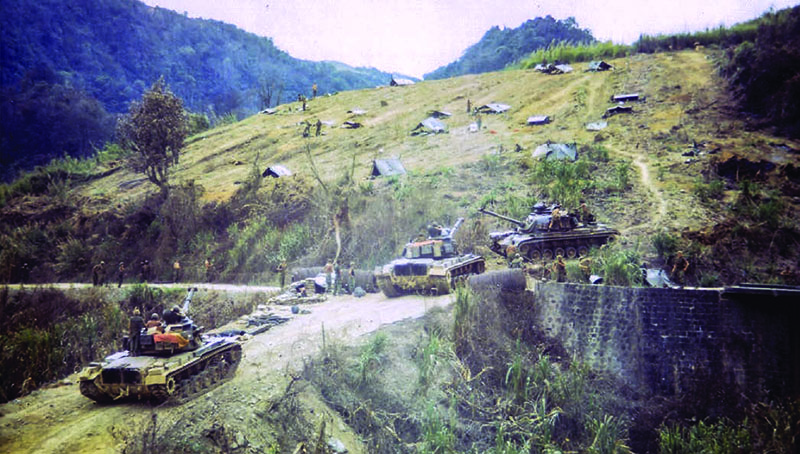
“Bravo One-Three, this is One-Two, over.”
No response. He tried several more times. Conklin finally responded.
“One-Two, this is One-Three.”
“One-Three, your main gun looks like it was hit and may be out of trunnion.”
“Roger, well I’ve been shot, and I’m not stickin’ my head to take a look!”
Unknown to Kellogg, Conklin somehow had been shot in the face, a wound that would result in the loss of one eye. B-13 sat defenseless against the renewed wave of NVA. Kellogg keyed his internal comms.
“Get us over there behind Buzz!”
Williams wheeled around to the other side of B-13, placing B-12 between Conklin and the bulk of enemy fire. Grunts hugged the dirt, pinned down across the front. A radioman directed B-12 toward a group of enemy attacking from bomb craters less than 50 feet away. At that close range, Trinidad could not depress the turret low enough to bring his guns to bear. With his .50-cal. out of commission and his turret-mounted guns useless, Kellogg resorted to the only weapons he had left.
He ordered Williams to hold course along a line of enemy-held craters, then snatched his grease gun and a handful of grenades from the rack behind him. Kellogg stood, half exposed above the cupola. The muffled sounds of gunfire inside the turret erupted into a deafening roar. Bullets zipped and cracked and pinged all around the tank. Kellogg flipped his grease gun upside down and opened fire. He prayed his unconventional firing technique might enlist the force of gravity to aid his faulty magazines feeding the bullets into the weapon. The tank approached the nearest crater. Kellogg pulled the pin on a grenade and lobbed it into the hole. He ducked as the explosion killed or stunned the sheltering NVA sol-diers. Kellogg resumed firing his grease gun upside down at near point- blank range. The next several bomb craters dotted the earth in an approaching batch. Kellogg steered Williams along-side, then tossed a grenade apiece into the holes until each fell silent.
Several stubborn enemy targeted Kellogg from a small crater in the tank’s path. Kellogg returned fire until the tank drove immediately alongside. He leaned out and dropped a grenade down into the hole. As the bomb exploded, Williams performed another neutral steer, crushing and grinding the dead and dying NVA beneath them.
Kellogg expended all 19 grenades wiping out enemy-held craters. His heart threatened to pound through his sternum as he collapsed back inside the tank. Some-how, despite the terrible toll the Marines exacted, NVA fire only in-creased. More than two hours had passed since they left the combat base. How much longer could they possibly survive?
Shell casings piled up inside B-12, further constricting the cramped turret. Trinidad sighted in another target. Lehman slammed in another high explo-sive round. Kellogg waited to observe the destruction his team efficiently wrought. A violent yellow flash suddenly blinded him. A terrific impact struck like a major leaguer’s bat to the chest. Kellogg folded on the turret floor. As he lay in utter silence, his memory inexplicably recalled a story from his youth of a relative who stopped breathing for several minutes in the hospital before doctors brought her back to life. Resurrected with the relative were the wonderful, luminous descriptions of the heaven that she wit-nessed while suspended between this life and the next. The sun-bathed glory she described had always impressed Kellogg. Now, he lay freezing, drowning and staring into a barren, black abyss.
“Oh, hell, I’ve gone to the wrong place.”
Cerda gathered his tankers in the road next to B-15. He lost track of how long Himes had been gone. When regiment finally located someone with authority, they denied the lieutenant’s request to support B-12 and B-13. Cerda never witnessed Himes lose his bearing, but this morning Himes was livid. After multiple requests, delays and denials, Himes stormed off to address the reg-imental office in person.
“The lieutenant said as soon as we get permission to go out, he’s riding in our tank as TC,” Cerda told his crew. “I’m going out with him. That means one of you has to stay behind.”
No one volunteered. Cerda made the Marines draw straws. Jack Butcher, his loader, came up short. Cerda assumed his spot inside the turret while LCpl John Cox took his place as B-15’s gunner and LCpl Clayton Larabell dropped into the driver’s seat.
Himes finally returned with orders. B-15 and B-14 were tasked to reinforce the beleaguered mine sweep along with the remainder of Fox Company. Himes instructed grunts to board his vehicles. The sun, now teeming with radiant fury, broiled the infantrymen crowding on top of the tanks and baked the crews hemmed inside. Cerda inspected his ammo racks and weapons. Sweat dripped from his nose as he leaned forward and rolled both pants legs to his knees. He stood in the open hatch above his head. Himes stood to his right in the TC hatch shouting orders into his headset and gesturing to the grunts swarming the road. A dozen Marines surrounded the turret, holding on wherever they could. A dozen more clung to B-14 behind them like barnacles to a ship’s bottom. The remainder piled into a 6×6 cargo truck or spread out on foot.
B-15 lumbered forward. Before lower-ing into his hatch, Cerda noticed a flak jacket tucked into the rack on the outside of the turret. Somehow, at some point, Butcher commandeered an army-style vest, more snuggly fitting and a superior construction to Marine-issued flaks. Cerda normally shunned the extra weight in the crowded interior but snatched the jacket and fastened it over his torso before wriggling down into his position. Just before 10 a.m., the two tanks and depleted infantry company surged out the gate.
The RPG penetrated B-12 through the side of the turret, detonating inside with the crew. Kellogg absorbed the brunt of the blast. He lay in a pile of shell casings drowning in his own blood. Trinidad slumped in his seat, alive but incapacitated. Lehman remained the only crewmember inside the turret able to fight. Ignoring his wounds, he struggled into a position around Trinidad and took over the trigger, laying down suppressive fire. He glanced at Kellogg. Surely, the TC was dead. When the gun ran dry, Lehman moved back to reload.
“One-Two, One-Three, this is Bravo One, over,” Himes hailed on the radio.
“This is One-Three,” Conklin replied.
“One-Two,” Lehman called in Kellogg’s stead as he fed a belt of ammo into the gun.
“Get back to base. We’ll take it from here. Well done.”
B-15 and B-14 halted near their fel-low stricken tanks. Grunts leaped from their sides and streamed out of the truck behind them. Himes ordered B-15 into the assault and commenced firing as soon as the grunts were clear. B-14, commanded by Cpl Pat Baddgor, followed into the fray.
Lehman poked his head through the loader’s hatch. Bullets cracked by and bounced off the steel around him. A blazing fire in the exterior cargo rack seared his face. The acrid smoke drove him back inside, hacking up black phlegm.
“Williams, the cavalry has arrived! Get us out of here!”
With his periscopes cracked, Williams operated the tank virtually blind. He threw the tank in reverse, backing away from the battle. The tank pitched suddenly forward, tossing Lehman across the turret. Without stopping, the tank abruptly pitched backward before level-ing out. Lehman stood in his hatch. The frame of a 6×6 truck lay ahead of B-12 in the road, hastily left in the tank’s path as the grunts poured into the battle, now flattened like a rolling pin. Lehman stooped inside the tank and gulped a breath of fresh air. He stood exposed, once more guiding Williams in reverse all the way back to Khe Sanh’s gate.
Now nearly three hours into the battle, the NVA escalated their effort in even greater proportion than the Marines. Enemy soldiers materialized seemingly everywhere. They dashed into the fight with polished parade uniforms wrapped in plastic and stowed in their backpacks, ready to don for their anticipated victory parade. They fought with fanaticism, as though Ho Chi Minh himself watched from a nearby hilltop impatiently waiting to collect his promised birthday present. Mortars and recoilless rocket fire rained down.
Within minutes of reaching the battlefield, Himes looked helplessly on as a mortar exploded in a group of Fox Company Marines, knocking out several officers and senior enlisted leaders. The company commander was quickly shot and killed. While Cerda, Cox and Larabell maneuvered the tank and poured continuous fire from the main gun, Himes remained exposed, hanging out the TC hatch and screaming to leaderless elements of grunts, directing them toward the enemy.
Cerda lost all sense of time as he loaded round after round into the main gun. Spent casings piled so high so quickly inside the turret that the hot brass burned his bare calves and singed the hair on his shins. A rapid succession of bullets thudding unsuppressed off metal above him stole his attention. His hatch stood wide open, leaving Cerda vulnerable.
“Would you look at that!” Himes shouted, as much to himself as to anyone else. “Those Marines are fighting hand-to-hand!”
Desperate for a glimpse, Cerda jumped up. The world outside brimmed in savage chaos. Marines and NVA soldiers collided in craters with buttstrokes and bayonets ordaining the victor of each individual struggle. Cerda returned to his seat after fewer than 30 seconds. Less than 30 seconds later, an RPG round detonated on the hatch still open above him. The concussion slammed him down to the turret floor. Shrapnel stitched across his back, absorbed by the flak jacket. His ears rang, his eyes watered uncontrollably, and his nose bled. He wiped his face until his vision cleared then lurched upward and secured the door.

B-15 fought on unhinged. Cerda maintained a relentless pace, feeding ammo to the insatiable guns while Cox tore the enemy apart. Ricocheting bullets pinged off the exterior armor in a neverending cacophony. The sharper thuds of ricocheting RPGs signaled more imminent danger. Several times, shell casings piled so high they blocked Cerda’s access to additional rounds and interfered with the rotation of the turret. Cerda opened his hatch long enough to shot put the empty shells through the opening.
Himes rotated in his cupola calling out targets. He pivoted just in time to witness an enemy RPG team staring down the sights directly at him. Before Himes could react, the NVA soldiers exploded into pieces. B-14, situated on Himes’ flank, spotted the enemy and the tank’s gunner, Cpl Rick Oswood, obliterated them with a high explosive round.
“One-Five, this is One-Four,” Baddgor called. “You’ve got Charlie climbing on your tank!”
Himes peered through his vision blocks. Several NVA soldiers mobbed the vehicle, scaling the rear away from the main gun.
“Roger One-Four,” Himes replied. “Scratch our back!”
The crew inside B-14 loaded a canister round while the turret rotated. Oswood locked B-15 in his sights and pulled the trigger. More than 1,200 steel pellets erupted at close range. The shrapnel ripped the radio antennas from the outside of B-15 and destroyed everything left in the exterior racks. The unfortunate, brave NVA soldiers who mounted the tank fell to the ground in mangled heaps of flesh.
B-12 reached Khe Sanh with the fire still burning in its cargo rack. Marines extracted each member of the wounded crew. They placed Kellogg on a stretcher awaiting immediate medical evacuation. Doctors assigned a Navy corpsman to remain by Kellogg’s side to keep him alive. NVA mortars exploded around the landing zone, forcing helicopters away. The corpsman and a battalion surgeon plugged the worst of Kellogg’s bleeding holes and started four IVs, one in each arm and leg, replenishing the tanker’s system with a barrage of fluids. A monstrous sense of helplessness overwhelmed Kellogg as someone finally loaded him onto a chopper. Door gunners opened up with their machine guns as they lifted off, showering the floor with spent brass rolling around Kellogg’s stretcher. All four fluid bottles ran dry. The corpsman looked frantic as he hooked up four more, clearly concerned he might fail to keep his charge alive.
A flurry of doctors met Kellogg aboard the hospital ship and rushed him down to surgery. Someone leaned over Kellogg’s battered face as they ran alongside his stretcher wheeling across the deck.
“Do you want a priest?”
Kellogg never considered himself especially religious but knew enough to understand that last rites were usually reserved for those crossing death’s doorstep.
“Do I need one?”
The battle outside Khe Sanh raged beyond midday. Time conspired against the Marines. Cerda swapped barrels on the .30-cal. when it overheated. He ran low on 90 mm rounds. An RPG detonated on the turret next to him. The metal inside glowed with bright orange spalling, barely containing the brunt of the explo-sion. Still, shrapnel blasted through the turret, peppering Cerda’s side. The flak jacket again saved him from catastrophic injury. Hot metal sliced through the communications cord attached to his helmet. One piece dug into his wrist, cutting cleanly through his watch band. Another RPG penetrated the turret, wounding Cerda a third time along with the rest of the crew. Exhausted, dehydrated, disoriented and bleeding, the tankers fought on.
The armored giant became the favored target of every RPG within range. Multiple penetrations into B-15’s engine crippled the transmission and ruptured the fuel tanks. Unable to move and running low on ammo, the tankers persevered. When an RPG damaged the remote firing mechanism for the coaxial machine gun, Cerda took over triggering the weapon. When the turret lost all electrical power, Cerda worked the hand crank, manually traversing the main gun. Smoke suffused through the rear of the turret from the engine compartment. Within minutes, the Marines inside choked down every breath.
“Put your gas masks on!” Himes ordered.
The tankers donned their masks and continued fighting. The infiltrating smoke soon morphed into licking fire. Himes called to his Marines through the smoke and kindling flames. Cerda leaned over the .30-cal., looking more dead than alive. Cox and Larabell, muffled by their gas masks, sounded in nearly as rough of shape. B-15 faced the irreversible end of its role in the battle. Himes weighed their options aloud.
“OK gents. Looks like we’ve got two choices. We can either stay in here and burn up with the tank or jump out and get shot. What do you want to do?”
Each crewmember threw off their gas masks and scrambled outside. Cox and Larabell leaped down and sprinted toward a nearby bomb crater. Himes discovered Cerda nearly limp and stuck inside the turret, severely weakened from blood loss. Himes grasped his arms and hoisted him out onto the fender. Cerda drifted in and out of consciousness, lying in the open while Himes jumped to the ground. Enemy fire poured on unabated. Himes snatched up Cerda over his shoulder in a fireman’s carry. Grunts lay down a barrage of covering fire as Himes plodded toward the crater with Cerda’s weight exacerbating painful shrapnel wounds in his legs. He stumbled and fell into the hole, his entire crew miraculously intact.
The tankers joined the grunts in shoot-ing, armed only with pistols and a grease gun. A jeep zipped past the bomb crater laden with ammo. When it circled back empty of cargo, Himes clambered out into the driver’s path with arms waving over his head. The driver halted long enough to load the wounded tank crew aboard, then sped back toward the combat base.
B-15’s crew underwent the same rapid triage as the B-12 tankers. Another med-evac chopper swooped in, lifting Himes and Cerda away. Elevated high above the battlefield, Himes spotted B-14 still under heavy bombardment. B-15 remained conspicuously paralyzed like a forbidding monument erected in memory of the tankers’ heroic deeds, a conflagration beneath a billowing plume of black smoke.
After nearly six hours of fighting, the battle’s outcome remained undecided. B-14 suffered multiple penetrating RPG hits, severely wounding crewmembers in-side before finally returning to base. The platoon’s fifth and final tank, B-11, deployed with another reinforcing wave of Marine infantry. Despite everything he already endured driving Kellogg’s B-12, Stanley Williams returned to the battlefield driving B-11. Golf Company, 2/1, advanced from Khe Sanh, along with Echo 2/3 sweeping in from another direction.
The fresh wave of infantry waded through a thick field of carnage. Dead bodies clogged the ground along their path. Discarded and damaged equipment littered the ravaged landscape. The Marines rearmed themselves along the way, commandeering machine guns and bayonets cast aside. They steered clear of B-15, still burning with rounds cooking off inside. They pushed into the fray, close enough to hear NVA jeers in accented English hurled their way alongside the bullets. The grunts fired back with, “Ho Chi Minh sucks!” and a serenade of machine guns.
Napalm finally broke the enemy’s back. A-4 Skyhawks streaked in so low the grunts could see the pilots’ faces as they dropped their terrifying ordnance. The firebombs exploded danger-close to Marines scattered across the field, some as close as 50 yards away. The Marines shielded themselves and gasped for breath as the flash inferno sucked the oxygen from the air and burned the enemy soldiers alive.
Both contestants embroiled in the birthday battle outside Khe Sanh suffered dearly. Eighteen Marines from 2/1 died, with several dozen more wounded. One of the KIA, Private First Class Patrick Riordan, would posthumously receive a Silver Star for his heroism. Lieutenant Colonel William R. Duncan, the battalion commander of 2/1, also received a Silver Star. The whole battalion received a Mer-itorious Unit Citation. According to the 3rd Tank Battalion command chron-ology, May 19 cost the NVA 165 confirmed KIA. The number of dead dragged away or wounded to escape the battlefield will never be known.
In terms of percentages, the tank platoon withstood perhaps the most shocking casualties. Eleven tankers received Purple Hearts, more than half of the platoon. Six of these required medical evacuation. All five of Himes’ tanks absorbed at least three RPG hits each, with B-15 incinerating on the battlefield as a complete combat loss. Miraculously, every tanker survived.
Surgeons counted 73 shrapnel holes spread across Kellogg’s body. They ex-tracted the largest pieces and stitched over the rest. Kellogg recuperated on the hospital ship for two weeks before stabilizing enough for a flight to Japan. He spent nearly a year fully recovering back in the States. The Corps assigned him as an instructor at the tank schoolhouse in Del Mar, Calif., to finish out his enlist-ment. For his role in the battle, Kellogg eventually received a Bronze Star with combat “V.”
Himes returned to the unit following his recovery. He walked with a cane but was determined once again to be with his Marines. After 10 months leading a tank platoon in combat and two harrowing medical evacuations, the battalion ordered Himes to finish out his tour in the rear. He remained on active duty following his time in Vietnam for another two years, eventually retiring as a lieutenant colonel in the Marine Corps Reserve.
Cerda shuffled through multiple hos-pitals after May 19. He spent several days fighting a blinding headache before doctors at a U.S. Air Force hospital finally X-rayed his head. They discovered a large chunk of metal embedded in his skull and rushed Cerda into surgery. Like Kellogg, Cerda finished out his enlistment and left active duty. In recognition of his part in the ambush, the Marine Corps presented Cerda with the Silver Star.
The passage of time has clouded the memory and significance of May 19. Today, the ambush exists in the shadows of larger events that took place around Khe Sanh. The exception lies within the battle’s survivors, who lived their lives in memory of their fallen brothers and defined by the experience. Kellogg en-dured decades of vivid nightmares that began before he was even evacuated from the battlefield in his semi-conscious state. He was convinced he had accidentally run over Marines during the battle. The compressed chaos surrounding his tank made the possibility inevitable, he believed. He refused to discuss the battle, despite its inescapable grip and undeniable impact on his later career in law enforcement. Not until 2003 at a reunion of Vietnam tankers did he begin to open up. The decision ushered in a new phase of camaraderie, understanding and healing.
Kellogg eventually connected with veterans from 2/1 who also survived the battle. He met a grunt who watched Kellogg’s tank in action throughout the engagement from less than 20 feet away. The veteran confirmed that Kellogg never ran over any Marines. For Kellogg, the news washed over like a cleansing rain. His nightmares vanished.
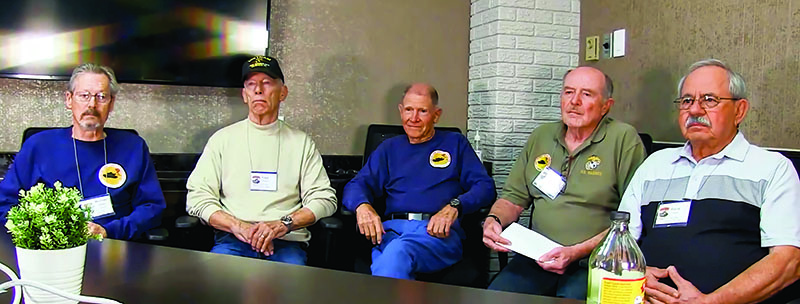
In 2008, Himes led an effort to reunite survivors on the 40th anniversary of the battle. Marines gathered from around the country at the National Museum of the Marine Corps in Triangle, Va., to reminisce and fill each others’ gaps in understanding. Himes, Cerda, Kellogg and many others from the platoon all joined numerous others from the infantry units that played a part. The resulting picture of May 19, 1968, proved more complete than ever before.
“A focused mission that can cost you your life is something that will forge a relationship that deserves to be kept,” Himes reflected during the reunion. Those relationships forged nearly 60 years ago persist even now.
The medals for valor some of the tank-ers received were downgraded from Himes’ original recommendations. Himes submitted Cerda to receive the Navy Cross. The rapid disintegration of his platoon also led to awards less than fitting for the heroism exhibited. Himes penned Kellogg’s award citation in the days following the ambush, large-ly unaware of the depth of courage and specific actions Kellogg had taken through–out the engagement. Those details would only be filled in over the ensuing decades. Eventually, Himes learned that Cox and Conklin both received the Silver Star, Larabell a Bronze Star with “V,” and Baddgor and Oswood both a Navy Commendation Medal. To this day, Himes remains convinced the valor of his men deserves much higher recognition.
“Heroism is just doing your job even though it’s scary and sometimes you’re a little scared,” Himes stated today. “The circumstances just pile up and it’s the aftermath that says whether you’re a hero. As far as I’m concerned, all my men are heroes.”
Author’s bio: Kyle Watts is the staff writer for Leatherneck. He served on active duty in the Marine Corps as a communications officer from 2009-13. He is the 2019 winner of the Colonel Robert Debs Heinl Jr. Award for Marine Corps History. He lives in Richmond, Va., with his wife and three children.
Featured Image (Top): Cpl Fred Kellogg seated on his cupola, covered in dirt after riding the second tank in line during a road march. Kellogg arrived in Vietnam in January 1968 and was quickly promoted to his role as TC. (Courtesy of Fred Kellogg)




